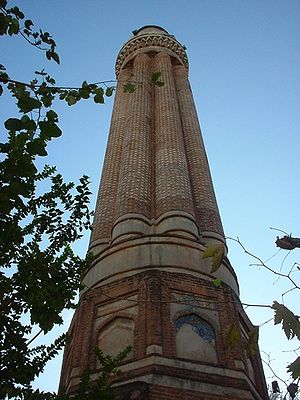
Yivli Minare Mosque
Encyclopedia

Antalya
Antalya is a city on the Mediterranean coast of southwestern Turkey. With a population 1,001,318 as of 2010. It is the eighth most populous city in Turkey and country's biggest international sea resort.- History :...
. The mosque's fluted minaret, which is decorated with dark blue tiles, is a landmark and symbol of the city. The mosque is located in Kaleiçi
Kaleiçi
Kaleiçi is the historic city center of Antalya, Turkey. Until modern times, almost the entire city was confined within its walls. It has structures dating from the Roman, Byzantine, Seljuk, Ottoman and modern Turkish republican eras...
(the old town centre) along Cumhuriyet Caddesi, next to Kalekapısı Meydanı.
History
The mosque was first built in 1230 and fully reconstructed in 1373. The minaretMinaret
A minaret مناره , sometimes مئذنه) is a distinctive architectural feature of Islamic mosques, generally a tall spire with an onion-shaped or conical crown, usually either free standing or taller than any associated support structure. The basic form of a minaret includes a base, shaft, and gallery....
is 38 metres (124.7 ft) high, built on a square stone base, with eight fluted sections and has 90 steps to the top.
The first building (1230) may have been a Byzantine
Byzantine Empire
The Byzantine Empire was the Eastern Roman Empire during the periods of Late Antiquity and the Middle Ages, centred on the capital of Constantinople. Known simply as the Roman Empire or Romania to its inhabitants and neighbours, the Empire was the direct continuation of the Ancient Roman State...
church originally and may have been converted into a mosque around 1225-7, during the reign of the Seljuk sultan Ala ad-Din Kay Qubadh I
Kay Qubadh I
Kayqubad I was the Seljuq Sultan of Rûm who reigned from 1220 to 1237. He expanded the borders of the sultanate at the expense of his neighbors, particularly the Mengujek emirate and the Ayyubids, and established a Seljuq presence on the Mediterranean with his acquisition of the port of Kalon...
(1220-1237). The original mosque was destroyed in the 14th century and a new mosque was built which, with its six domes, is one of the oldest examples of multi-dome construction in Anatolia
Anatolia
Anatolia is a geographic and historical term denoting the westernmost protrusion of Asia, comprising the majority of the Republic of Turkey...
.
Today the building houses the Antalya Ethnographic Museum and contains clothing, kitchen utensils, embroidery, tapestries and looms, socks, sacks, kilim
Kilim
Kilims are flat tapestry-woven carpets or rugs produced from the Balkans to Pakistan. Kilims can be purely decorative or can function as prayer rugs. Recently-made kilims are popular floor-coverings in Western households.-Etymology:...
s, ornaments, and nomadic tents. It was opened to the public in 1974.

